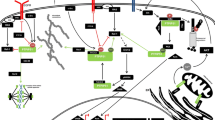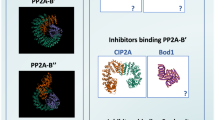Abstract
This study investigated the regulation of 14-3-3β binding to PTPIP51 by the tyrosine phosphorylation status of PTPIP51. The tyrosine 176 residue is phosphorylated by c-Src. Up to now, nothing is known about the impact of such well-established phosphorylation events on the interaction profile of PTPIP51 with its partners of the mitogen-activated protein kinase (MAPK) pathway. In human keratinocytes the PTPIP51 phosphorylation was varied by inhibiting the phosphatase activity, thus enhancing the phosphorylation of PTPIP51. Differential blocking of Src kinase family members (despite c-Src) by PP2 increased the activity of c-Src and the tyrosine phosphorylation of PTPIP51 at position 176, which is the substrate of c-Src kinase. The amount of PTPIP51 interactions with 14-3-3β, Raf-1, PTP1B and c-Src was evaluated and the resulting data were compared to an untreated control group. The increased phosphorylation level resulted in a sharp drop of the 14-3-3β/PTPIP51 and 14-3-3β/Raf-1 interaction. Besides the 14-3-3 interaction of PTPIP51, the interaction with the two MAPK modulators, protein kinase A (PKA) and diacylglycerol kinase alpha (DAGKα), are also regulated by the tyrosine phosphorylation status of PTPIP51. Additional immunostaining experiments were done investigating the functional implication on these interactions of the phosphorylation in apoptotic processes. In the pervanadate- and PP2-treated HaCaT cells, higher amounts of apoptotic cells were not detected as compared to the control group. The presented data confirms a tyrosine phosphorylation-dependent interaction of PTPIP51 with 14-3-3β and Raf-1 in vivo and a tyrosine-dependent interaction profile with DAGKα and PKA. The non-interaction of PTPIP51 with 14-3-3 is not sufficient for triggering apoptosis.










Similar content being viewed by others
References
Stenzinger, A., Schreiner, D., Koch, P., Hofer, H. W., & Wimmer, M. (2009). Cell and molecular biology of the novel protein tyrosine-phosphatase-interacting protein 51. International Review of Cell and Molecular Biology, 299(275), 183–246.
Petri, M. K., Koch, P., Stenzinger, A., Kuchelmeister, K., Nestler, U., Paradowska, A., et al. (2011). PTPIP51, a positive modulator of the MAPK/Erk pathway, is upregulated in glioblastoma and interacts with 14-3-3β and PTP1B in situ. Histology and Histopathology, 26, 1531–1543.
Bobrich, M., Brobeil, A., Mooren, F. C., Krüger, K., Steger, K., Tag, C., Wimmer, M. (2011). PTPIP51 interaction with PTP1B and 14-3-3β in adipose tissue of insulin-resistant mice. International Journal of Obesity. doi:10.1038/ijo.2010.283.
Brobeil, A., Graf, M., Oeschger, S., Steger, K., & Wimmer, M. (2010). PTPIP51—a myeloid lineage specific protein interacts with PTP1B in neutrophil granulocytes. Blood Cells, Molecules, & Diseases, 45, 159–168.
Brobeil, A., Bobrich, M., Graf, M., Kruchten, A., Blau, W., Rummel, M., et al. (2011). PTPIP51 is phosphorylated by Lyn and c-Src kinases lacking dephosphorylation by PTP1B in acute myeloid leukemia. Leukemia Research, 35, 1367–1375.
Yu, C., Han, W., Shi, T., Lv, B., He, Q., Zhang, Y., et al. (2008). PTPIP51, a novel 14-3-3 binding protein, regulates cell morphology and motility via Raf-ERK pathway. Cellular Signalling, 20, 2208–2220.
Brobeil, A., Bobrich, M., & Wimmer, M. (2011). Protein tyrosine phosphatase interacting protein 51—a jack-of-all-trades protein. Cell and Tissue Research, 344, 189–205.
Häfner, S., Adler, H. S., Mischak, H., Janosch, P., Heidecker, G., Wolfman, A., et al. (1994). Mechanism of inhibition of Raf-1 by protein kinase A. Molecular and Cellular Biology, 14, 6696–6703.
Mérida, I., Avila-Flores, A., & Merino, E. (2008). Diacylglycerol kinases: At the hub of cell signalling. Biochemistry Journal, 409, 1–18.
Huyer, G., Liu, S., Kelly, J., Moffat, J., Payette, P., Kennedy, B., et al. (1997). Mechanism of inhibition of protein–tyrosine phosphatases by vanadate and pervanadate. Journal of Biological Chemistry, 272, 843–851.
Koch, P., Viard, M., Stenzinger, A., Brobeil, A., Tag, C., Steger, K., et al. (2009). Expression profile of PTPIP51 in mouse brain. The Journal of Comparative Neurology, 517, 892–905.
Yudushkin, I. A., Schleifenbaum, A., Kinkhabwala, A., Neel, B. G., Schultz, C., & Bastiaens, P. I. (2007). Live-cell imaging of enzyme–substrate interaction reveals spatial regulation of PTP1B. Science, 315, 115–119.
Galic, S., Hauser, C., Kahn, B. B., Haj, F. G., Neel, B. G., Tonks, N. K., et al. (2005). Coordinated regulation of insulin signaling by the protein tyrosine phosphatases PTP1B and TCPTP. Molecular and Cellular Biology, 23, 819–829.
Reiland, J., Ott, V. L., Lebakken, C. S., Yeaman, C., McCarthy, J., & Rapraeger, A. C. (1996). Pervanadate activation of intracellular kinases leads to tyrosine phosphorylation and shedding of syndecan-1. Biochemistry Journal, 319, 39–47.
Ewing, R. M., Chu, P., Elisma, F., Li, H., Taylor, P., Climie, S., et al. (2007). Large-scale mapping of human protein–protein interactions by mass spectrometry. Molecular Systems Biology, 3, 89.
Jin, J., Smith, F. D., Stark, C., Wells, C. D., Fawcett, J. P., Kulkarni, S., et al. (2004). Proteomic, functional, and domain-based analysis of in vivo 14-3-3 binding proteins involved in cytoskeletal regulation and cellular organization. Current Biology, 14, 1436–1450.
Niemantsverdriet, M., Wagner, K., Visser, M., & Backendorf, C. (2008). Cellular functions of 14-3-3 zeta in apoptosis and cell adhesion emphasize its oncogenic character. Oncogene, 27, 1315–1319.
Hehner, S. P., Hofmann, T. G., Dröge, W., & Schmitz, M. L. (1999). Inhibition of tyrosine phosphatases induces apoptosis independent from the CD95 system. Cell Death and Differentiation, 6, 833–841.
Lv, B. F., Yu, C. F., Chen, Y. Y., Lu, Y., Guo, J. H., Song, Q. S., et al. (2006). Protein tyrosine phosphatase interacting protein 51 (PTPIP51) is a novel mitochondria protein with an N-terminal mitochondrial targeting sequence and induces apoptosis. Apoptosis, 11, 1489–1501.
Horiuchi, K. Y., Wang, Y., Diamond, S. L., & Ma, H. (2006). Microarrays for the functional analysis of the chemical-kinase interactome. Journal of Biomolecular Screening, 11, 48–56.
Kilarski, W. W., Jura, N., & Gerwins, P. (2003). Inactivation of Src family kinases inhibits angiogenesis in vivo: Implications for a mechanism involving organization of the actin cytoskeleton. Experimental Cell Research, 291, 70–82.
Hanke, J. H., Gardner, J. P., Dow, R. L., Changelian, P. S., Brissette, W. H., Weringer, E. J., et al. (1996). Discovery of a novel, potent, and Src family-selective tyrosine kinase inhibitor. Study of Lck- and FynT-dependent T cell activation. Journal of Biological Chemistry, 271, 695–701.
Biscardi, J. S., Maa, M. C., Tice, D. A., Cox, M. E., Leu, T. H., & Parsons, S. J. (1999). c-Src-mediated phosphorylation of the epidermal growth factor receptor on Tyr845 and Tyr1101 is associated with modulation of receptor function. Journal of Biological Chemistry, 274, 8335–8343.
Tice, D. A., Biscardi, J. S., Nickles, A. L., & Parsons, S. J. (1999). Mechanism of biological synergy between cellular Src and epidermal growth factor receptor. The Proceedings of the National Academy of Sciences of the United States of America, 96, 1415–1420.
Kraft, C. A., Garrido, J. L., Fluharty, E., Leiva-Vega, L., & Romero, G. (2008). Role of phosphatidic acid in the coupling of the ERK cascade. Journal of Biological Chemistry, 283, 36636–36645.
Acknowledgments
We thank Mr. M. Bodenbenner, Ms. S. Gombert and Mr. M. Ivo (Institute of Anatomy and Cell Biology, Giessen) for their excellent technical assistance.
Author information
Authors and Affiliations
Corresponding author
Rights and permissions
About this article
Cite this article
Brobeil, A., Bobrich, M., Tag, C. et al. PTPIP51 in Protein Interactions: Regulation and In Situ Interacting Partners. Cell Biochem Biophys 63, 211–222 (2012). https://doi.org/10.1007/s12013-012-9357-y
Published:
Issue Date:
DOI: https://doi.org/10.1007/s12013-012-9357-y




